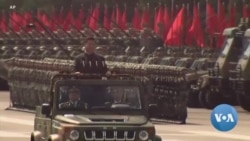WHITE HOUSE - As the war on Ukraine rages, Russia remains the biggest and most immediate threat for NATO. However, as allied leaders meet for their summit in Vilnius, Lithuania, next week, a key agenda item will be to implement the Strategic Concept adopted during the Madrid summit in 2022, where the alliance recognized security challenges emanating from China.
NATO’s strategic concept states that the alliance faces “systemic competition” from Beijing’s “ambitions and coercive policies” that challenge members’ “interests, security and values.”
While allies may agree that the China challenge is real, they differ in how to address it. Many European countries rely heavily on Chinese investment and trade. China makes up almost 10% of Europe's exports and about 20% of its imports.
In Vilnius, those differences will need to be hammered out and leaders will need to forge a common approach in dealing with the China threat, said Anca Agachi, associate director and resident fellow for Transatlantic Security Initiative in the Scowcroft Center for Strategy and Security at the Atlantic Council.
“The big question that exists right now within the transatlantic community is what is NATO’s role when it comes to China, and how far exactly should the alliance go,” she told VOA.
Ukraine-Taiwan
NATO leaders have warned that what is happening in Europe today can happen in Asia tomorrow.
“If [Russian] President [Vladimir] Putin wins in Ukraine, this would send the message that authoritarian regimes can achieve their goals through brute force,” NATO Secretary-General Jens Stoltenberg said in Tokyo earlier this year. “This is dangerous. Beijing is watching closely, and learning lessons, which may influence its future decisions."
Stoltenberg was referring to Beijing’s future decisions on Taiwan, a self-governing island Beijing considers its wayward province.
U.S. President Joe Biden has on several occasions said that American forces would defend Taiwan in the event of a Chinese invasion. That would create a risk of NATO allies and other U.S. partners being drawn into the conflict – a contingency plan the alliance would need to plan for.
Such war is “neither inevitable nor imminent,” Army General Mark Milley, the Joint Chiefs of Staff chairman, said during a House Armed Services Committee hearing in March.
Hybrid and cyber operations
Beyond Taiwan and freedom of navigation concerns, NATO is anxious about other potential threats, including what it calls Beijing’s “malicious hybrid and cyber operations and its confrontational rhetoric and disinformation.”
The alliance views China as seeking to control key technological and industrial sectors, critical infrastructure such as 5G, and strategic materials and supply chains. It accuses Beijing of using economic leverage to “create strategic dependencies and enhance its influence.”
“More generally, Chinese political influence in Europe is, of course, a growing concern,” Agachi added, particularly considering Beijing’s growing partnership with Russia.
Beijing insists that it “stands on the side of peace” on Ukraine. It has hit back on NATO, including on floated plans to establish a NATO office in Japan.
“Asia lies beyond the geographical scope of the North Atlantic and has no need for a replica of NATO. However, we have seen NATO bent on going east into this region, interfering in regional affairs and inciting bloc confrontation,” Chinese Foreign Ministry spokesperson Wang Wenbin said last month. “What is NATO really up to? This calls for high vigilance among countries in the world, particularly in Asia.”
Indo-Pacific partners
Indo-Pacific partners Australia, Japan, New Zealand and South Korea attended the NATO summit last year and will again participate in Vilnius.
“These Indo-Pacific countries, they have a unique experience engaging with the PRC and can bring some valuable perspective to that discussion,” National Security Council spokesperson John Kirby said in an interview with VOA on Thursday.
NATO has said it remains “open to constructive engagement” with Beijing.
Iuliia Iarmolenko contributed to this report.










